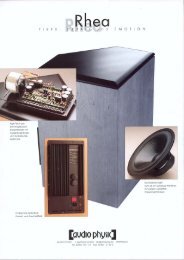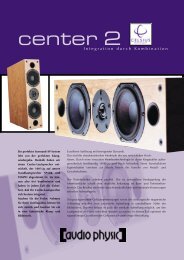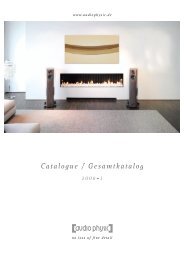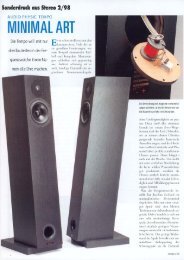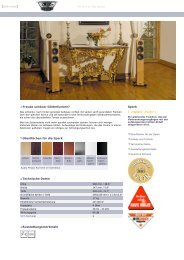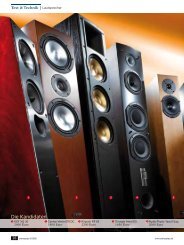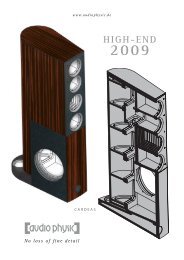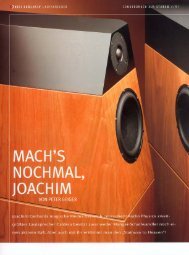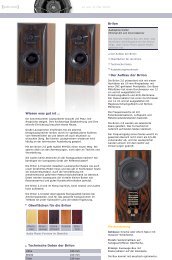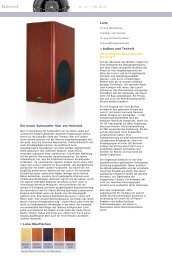Audio Physic Scorpio Loudspeakers
Audio Physic Scorpio Loudspeakers
Audio Physic Scorpio Loudspeakers
Create successful ePaper yourself
Turn your PDF publications into a flip-book with our unique Google optimized e-Paper software.
April 2006<br />
<strong>Audio</strong> <strong>Physic</strong><br />
<strong>Scorpio</strong> <strong>Loudspeakers</strong><br />
A 20 year Tradition!<br />
Review By Todd Warnke<br />
Click here to e-mail reviewer.<br />
In a house with two young boys,<br />
the sound comes from everywhere.<br />
And, of course, you are always<br />
listening, even to background<br />
sounds, in case of an accident. So,<br />
one evening while working in my<br />
office and just after the <strong>Audio</strong> <strong>Physic</strong><br />
<strong>Scorpio</strong> loudspeakers had shown up<br />
for review, I quietly registered the<br />
sounds of Miles and Erik made<br />
playing with their mother’s guitar in<br />
the living/listening room. Which<br />
means that several seconds later I<br />
was quite startled when I also heard them playing with their<br />
bikes in the backyard. And that is the exact moment that I<br />
realized that the <strong>Scorpio</strong>s just might prove to be very<br />
special loudspeakers.<br />
<strong>Audio</strong> <strong>Physic</strong>, located in Brilon Germany, has spent the last<br />
20 years building one of the most enviable names in the<br />
audiophile world by combining advanced technical design<br />
and superb cabinetry with a unique approach to room<br />
placement, serving the result up in a surprisingly broad<br />
lineup. Starting with the sleek Yara at about $1800, and<br />
reaching all the way to the $70,000 Khronos, chances are<br />
<strong>Audio</strong> <strong>Physic</strong> has a loudspeaker to fit both your room and<br />
budget. That said, one thing I have always appreciated<br />
about <strong>Audio</strong> <strong>Physic</strong>, unlike other companies who may have<br />
several lines with differing sounds, is that each step up<br />
gets you the same sound, only more of it. Likewise, each<br />
new generation of loudspeaker is the same, only more<br />
refined. This speaks well of their confidence in the basic<br />
approach they take to speaker design. Indeed, their motto,<br />
"No Loss of Fine Detail," has consistently been reflected in<br />
each model they make.
Bitten By A New Tradition<br />
The <strong>Scorpio</strong> is the newest <strong>Audio</strong> <strong>Physic</strong> loudspeaker and,<br />
at $6495, sits at a rather tricky price point. Anyone who<br />
would casually consider the <strong>Scorpio</strong>s can probably afford a<br />
much more expensive loudspeaker, and yet it is a big<br />
reach for the majority of the market. So, to be successful<br />
the <strong>Scorpio</strong> has to offer a balanced and deep set of skills<br />
so that it can lure budget-constrained folk up the price<br />
ladder and also convince those with larger wallets that<br />
buying it is all they need do, and that they can then spend<br />
a portion of their loudspeaker budget on other things, like,<br />
say, the wife. To that end, the specifications of the <strong>Scorpio</strong><br />
indicate that it has been designed to be a serious, last stop<br />
purchase.<br />
With a rated bandwidth of 30Hz to 33kHz, the range of the<br />
<strong>Scorpio</strong> covers all the acoustical music scale with room to<br />
spare on both ends. The sensitivity is a quite good<br />
91dB/W/m and is high enough that odds are whatever you<br />
are using to drive your current loudspeakers will most likely<br />
be able to handle the <strong>Scorpio</strong>s as well. Of course, physics<br />
being what it is, and in line with the old joke about cheap,<br />
fast and good, you can pick two of these three —<br />
bandwidth, sensitivity and high impedance — but not all<br />
three. So the 4-Ohm load of the <strong>Scorpio</strong>s is not a surprise.<br />
Fortunately, it is a fairly flat 4 Ohms and so does not<br />
present a difficult load to a well-designed amplifier. <strong>Audio</strong><br />
<strong>Physic</strong> recommends at least 25 watts to drive the <strong>Scorpio</strong>s.<br />
My experience shows that that figure is conservative as I<br />
used both a 30 watt and a 16 watt amplifier for most of the<br />
time the <strong>Scorpio</strong>s were in my room and never had a<br />
problem.<br />
The computer designed and machined<br />
cabinet is shaped like a teardrop, with the<br />
tip pointed at the listener, and with both the<br />
front and back shaved flat. The narrower<br />
front baffle holds a single 1 inch soft dome<br />
tweeter, a 6 inch midrange driver and a<br />
second 6 inch driver in a woofer-midrange<br />
configuration. Mounted on each side of the<br />
cabinet is a pair of 7-inch woofers, for a<br />
total of 4 woofers and 7 drivers per cabinet.<br />
<strong>Audio</strong> <strong>Physic</strong> calls this a 3.5 way design as<br />
the two 6-inch drivers share responsibility<br />
for the midrange, but are crossed over at<br />
different frequencies. The speaker also<br />
uses two bass reflex ports, one mounted<br />
midway up the rear of the cabinet and the other venting on<br />
the bottom. The crossover is located on the lower rear of<br />
the cabinet and uses the new <strong>Audio</strong> <strong>Physic</strong> VCT (vibration
control terminal) technology. Basically, VCT is a solid<br />
aluminum block, mounted to the cabinet using an<br />
electrometer (neoprene) to isolate it from the cabinet and<br />
unwanted vibrations. Speaker wire connections are made<br />
via a single pair of well-made and easy to use WBT binding<br />
posts per speaker.<br />
At 43 inches tall and 16 inches deep, the <strong>Scorpio</strong> could<br />
look very imposing. At just 8 inches wide they are quite<br />
graceful, especially since the supplied 11.5-inch wide<br />
outrigger footers add width to the speakers only at the<br />
bottom, enhancing both the stability of the loudspeaker and<br />
their elegant looks. Tilted back at 7 degrees, the cabinet<br />
time aligns the front drivers and, again, adds to the overall<br />
stylishness of the design. The finish work on the real<br />
veneer (two types of maple, ash, cherry, ebony and<br />
rosenut) is seamless and first class in every way. Lastly,<br />
every <strong>Audio</strong> <strong>Physic</strong> loudspeaker comes with a 10-year<br />
warranty.<br />
Associated Gear & The Room<br />
While reviewing the <strong>Scorpio</strong>s I used the following gear.<br />
Digital sources were a Cary CD-303/200, a Berendsen<br />
CD1, a Blue Circle BC501 and my extremely customized<br />
Assemblage DAC1. The reference pre-amplifier was my<br />
First Sound Presence Statement while a ModWright SWL<br />
9.0SE also saw a considerable amount of time in the<br />
system. Power came primarily from an Art <strong>Audio</strong> Carissa<br />
and a Blue Circle BC6, while other loudspeakers were my<br />
reference Merlin VSM-Ms, Triangle Antals, and DeVore<br />
Fidelity Gibbon Super 8s. Cabling was from Cardas,<br />
Acoustic Zen, <strong>Audio</strong> Magic, Stereovox and Shunyata<br />
Research — the last of which also supplied power<br />
conditioning.<br />
And now a brief note about room<br />
placement. In the past, much has been<br />
written about the <strong>Audio</strong> <strong>Physic</strong> method of<br />
room placement, and <strong>Audio</strong> <strong>Physic</strong><br />
themselves have a very educational and<br />
interesting section of their site devoted to<br />
the topic. At root, the point they make is<br />
very simple and yet often overlooked —<br />
your room reflects a bunch of sound and<br />
messes up your loudspeakers. According<br />
to <strong>Audio</strong> <strong>Physic</strong> this happens in three<br />
distinct ways. First, bass is affected by<br />
boundaries so getting your loudspeakers<br />
out into the room will clean up the bass.<br />
Second, the sidewall will reflect mid and<br />
upper range sounds, and if they are place too close to the
sidewall, the result is a perceived shift in the speaker<br />
location as well as smearing of fine detail. And third,<br />
reverberations in your room are at a constant level<br />
regardless of where you are in the room, but direct sound<br />
from the loudspeakers is cut in half each time you double<br />
your distance from them. These three points add up to a<br />
recipe for placement that is somewhat unusual. With the<br />
speakers pushed up into the room (for the bass) and a<br />
specific distance from the sidewall (see their site for the<br />
number and why), instead of the standard equilateral<br />
triangle with the listener at the point, the <strong>Audio</strong> <strong>Physic</strong><br />
method results in a triangle where the loudspeakers are<br />
spread about 20 percent wider. In many rooms this can<br />
best be achieved by moving the speakers to the long wall,<br />
rather then the typical short wall. And, to combat room<br />
reverb the method can also result in a fairly nearfield setup,<br />
with the speakers being set away from you by about 6 to 7<br />
feet.<br />
I first used this type of setup many years ago when my<br />
then listening room forced it on me. With one short wall<br />
being taken up with a fireplace and a sliding glass door,<br />
and the other with an entry to the kitchen and the front<br />
door, a long wall location was the only option, and the idea<br />
stuck. In every room since I have tried the long wall and<br />
the short wall, and have often had great success with the<br />
long wall. I have also tried using speakers in the relative<br />
nearfield (though no where as near as Steve Stone does in<br />
his excellent desktop system survey) and, again, have<br />
found that it usually works quite nicely. There are<br />
exceptions of course, but this method can reduce bass<br />
modes, sidewall reflections and interference from room<br />
reverb. For this review I tried the <strong>Audio</strong> <strong>Physic</strong> method as<br />
well the Cardas method (found on their website) and had<br />
good results with both — though as you’d guess the <strong>Audio</strong><br />
<strong>Physic</strong> way was slightly better this time. Ok, enough setup,<br />
let’s see if this <strong>Scorpio</strong> has a sting.<br />
A Bite To Like?<br />
Starting in the middle, the way the <strong>Scorpio</strong> handles female<br />
voices is nigh unto stunning. I have listened to each and<br />
every Joni Mitchell album at least 200 times, and to Court<br />
and Spark [DCC GZS 1025] at least 1000. As an album it<br />
is perfect, with every cut being true A list material and each<br />
song taking an honest, revealing yet different angle on<br />
love’s uncertainties. But as a recording, and in spite of it<br />
often being sited as an audiogeek favorite, it has issues.<br />
Take the title track, for example. On mid-fi speakers it all<br />
sounds pretty nice, with good separation and nice tonality.<br />
On solid high-end loudspeakers it is quite obvious that Joni<br />
is singing in an isolation booth (of course a quick read of
the liner notes would tell you the same thing as that’s Joni<br />
opening the song on the piano, panned hard left, while her<br />
vocal is just left of center, and without piano<br />
accompaniment). This is cool stuff for sure. Taking it<br />
further, on superb loudspeakers you can hear the<br />
dimensions of the isolation booth. Again cool — at least if<br />
you are into that whole aural dissection thing. But the great<br />
loudspeakers (and I’m not saying the <strong>Scorpio</strong> is one of<br />
those... yet), take an almost Seurat-like, pointillist view of<br />
things, allowing you to focus tight and see the dots that<br />
make up the painting, but when you take an audio step<br />
back they snap the music into an impressionistic whole.<br />
Through the <strong>Scorpio</strong>s, this effect was true magic. Zoom in,<br />
and there was detail galore — one time I even thought I<br />
could hear the brand of screws used to make that isolation<br />
booth — but relax the left side of the brain and<br />
unadulterated Joni was released. Sure, she was singing in<br />
a box, but she was not confined at all as each note soared<br />
with a purity I have heard only with one or two other<br />
loudspeakers. Or more significantly, in person. Now that’s<br />
cool.<br />
For more vocal games in altogether different registers, the<br />
most recent studio album from Los Lobos The Ride<br />
[Hollywood 2061-62443- 2] departs from their usual style,<br />
as it features no less than 9 duets spread across 13 tracks.<br />
It is filled with a variety of guest vocals from soul stars<br />
Mavis Staples and Bobby Womack, to Brits Richard<br />
Thompson and Elvis Costello, Latin stars Café Tacuba,<br />
Little Willie G and Ruben Blades, plus local L.A. heroes<br />
Tom Waits and Dave Alvin. For most groups this would be<br />
too diffuse to work, but rather than flop the variety<br />
showcases what we Lobos fans have always known, they<br />
are simply the American band of the last 30 years. The<br />
track with Dave Alvin, Somewhere in Time, is a particular<br />
favorite of mine. A countrified, Latin lope of longing, it pairs<br />
Alvin’s masculine bass with the tonally opposite but no less<br />
masculine tenor of David Hidalgo. The earthy Alvin and the<br />
celestial Hidalgo alternate verses, but when they join for<br />
the chorus the <strong>Scorpio</strong>s shows their mettle as they cleanly<br />
stack the two lines while also drawing out each fine strand<br />
of timbre. This is harder than normal as the mix places<br />
both vocalists dead center, so staging hinders rather than<br />
helps in distinguishing them. But the <strong>Scorpio</strong> has such fine<br />
control of each nuance that, even sitting in each other’s<br />
lap, I found it easy to follow either vocalist.<br />
Dropping down the response graph, on Richard<br />
Thompson’s The Old Kit Bag [Spin Art 126] recruits (no<br />
relation) Danny Thompson for the bass work. On First<br />
Breath, we get the privilege of hearing Richard on acoustic<br />
guitar and Danny on acoustic double-bass. Having started<br />
as a jazz bassist (his first solo album was a trio recording<br />
with John McLaughlin), before moving on to British blues
and folk music, Danny has a feel for the bass that<br />
simultaneously encompasses all three disciplines, which is<br />
just one reason why he is the dean of British bass players.<br />
Anyway, they open this track with a duet that adds<br />
Richard’s vocal and slowly brings in Michael Jerome’s<br />
drums. The song — a meditation on finding love late in life,<br />
but at least finally finding it — moves in a dignified, at times<br />
floating procession that is suspended by the subtle bass<br />
line that plays hide and seek with the tom-toms. However,<br />
as good as the lyrics are, the heart of the song lies in the<br />
last two and half minutes where all three players probe the<br />
lessons of time. With the <strong>Scorpio</strong>s, the details of this<br />
interplay were vivid, with deep, smooth, even and powerful<br />
bass. Though not a wall-buster, the bass filled the room<br />
with tonally correct, taut rhythm.<br />
Up top, this track also showed the skill of the soft-dome<br />
tweeter. Jerome plays some exquisite cymbals, sneaking<br />
into the song with a soft spray of stickwork before gradually<br />
working in the rest of his kit. I have a small drum kit in the<br />
basement (don’t ask) and when no one is around sneak<br />
down there to make an unholy racket. Anyway, getting that<br />
soft spray sound spot on is about as hard a task as any<br />
tweeter can attempt. The leading edge must be an<br />
instantaneous jump while never veering into harshness,<br />
while the trailing edge needs to offer an almost insane<br />
amount of subtle detail. <strong>Audio</strong> <strong>Physic</strong> accomplished both<br />
with a skill that was a near perfect mirror of the sound I<br />
hear in basement.<br />
For staging I turned to an old favorite Te Deum by Arvo<br />
Pärt [ECM 1505]. Recorded in Lohjan Kirkko, the third<br />
largest stone church in Finland, the building is a simple but<br />
gorgeous, gothic masterpiece, complete with murals and a<br />
wooden belfry. Completed approximately 1480, it features<br />
high walls to reflect and extend decay with numerous<br />
internal arches to diffuse the sound. The resonant walls<br />
give the recording a warm glow, highlighting, especially,<br />
the wonderful female voices in the 28-member Estonian<br />
Philharmonic Chamber Choir. To top it off, the album<br />
includes several pictures from the recording sessions,<br />
allowing you to actually see the staging before trying to<br />
aurally decode the same information. With the <strong>Audio</strong><br />
<strong>Physic</strong> loudspeakers the singers — moving left to right<br />
from soprano to bass — were physically spread and easy<br />
to pinpoint even as the hall effect granted a resplendent<br />
halo over the proceedings. The Tallinn Chamber Orchestra<br />
with prepared piano hard right, violins hard left and basses,<br />
cellos and violas in the center, were likewise arrayed in an<br />
easy to follow manner, helping to create the illusion of<br />
attending a live performance.<br />
Dynamically, in my room the <strong>Scorpio</strong>s showed very well,<br />
with a clean, explosive but never biting leading edge. While
not the very best that I’ve had in my room in this area, it<br />
was among them and acquitted itself quite well in this<br />
regard. But what sets it apart from almost every other<br />
loudspeaker I’ve heard in my home was spooky way it<br />
resolved decay. Sure, the attack is vital as it forms the<br />
initial impression of each instrument, but when the decay is<br />
this good it too is very convincing. On good recordings this<br />
allowed me to hear what took place at the session, while<br />
with great recordings it made me feel I was there.<br />
And speaking of decay, my ability to hear deep into the<br />
noise floor revealed layer upon layer of information. Best of<br />
all, and as I alluded to in the Joni Mitchell section of this<br />
review, detail was never presented as dissertation on the<br />
recording session, rather it was full of blood, sweat and<br />
emotion. And this came across on every type of recording<br />
— The Hot Five sessions by Louis Armstrong felt every bit<br />
as real as Cowboy Junkies Trinity Sessions, if far worse of<br />
a recording. This allowed me to put any type of music in<br />
the system, from any era and enjoy it completely. Yet<br />
another skill that allowed this is the fact that the <strong>Scorpio</strong>s<br />
were pretty agnostic when it comes to volume, sounding<br />
convincing at midnight the kids are sleeping volume as well<br />
as 2 p.m. on Saturday, let’s have a party levels.<br />
A final note on their sound, in swapping out gear to explore<br />
the limits of the <strong>Audio</strong> <strong>Physic</strong> loudspeakers I found that<br />
they worked best with neutral to very slightly warm gear.<br />
So Cardas Neutral Reference worked better than<br />
Stereovox cabling and the Blue Circle BC6 power amplifier<br />
was a better match than the Art <strong>Audio</strong> Carissa. To be sure<br />
the <strong>Scorpio</strong>s sounded great with the Carissa (a favorite of<br />
mine, but a touch warm), most especially when using the<br />
built in volume attenuator, but with the Blue Circle there<br />
was just a bit more detail there, and without compromising<br />
emotion.<br />
Venomous?<br />
So, what’s not to like? Obviously, very little but looking with<br />
a microscope I can find these things. First, while perfectly<br />
balanced for my room and tastes, the bass could go a bit<br />
deeper and be a bit fuller. As for the deeper part, I do not<br />
much listen to music with deep bass sound effects, though<br />
some of the electronica I enjoy occasionally ventures south<br />
of 30Hz. When it did the <strong>Scorpio</strong>s, as with any ported<br />
loudspeaker, rolled off quickly. Again, for my tastes this<br />
was not an issue as my main listening room has problems<br />
with bass when it gets below 30Hz or so, but for others<br />
with different rooms and tastes I point it out here. Again, in<br />
my slightly larger than medium sized room, no problem, but<br />
if you have a large listening room and love deep bass, the
next step up the <strong>Audio</strong> <strong>Physic</strong> line would probably be a<br />
better match. And as for the fullness, depending on room<br />
setup the bass showed a very slight dip between about<br />
50Hz and 70Hz. This was more of an issue when I set<br />
them up on the long wall, but since everything else about<br />
that setup was a touch better than with the speakers on the<br />
short wall, it was a compromise I could live with. Lastly, in<br />
a perfect loudspeaker the attack would be every bit as<br />
perfect as the decay was with the <strong>Scorpio</strong>s. But to keep<br />
some kind of perspective here, the decay I heard in my<br />
room was so exceptional that this is a standard that is<br />
probably unfair.<br />
A New Star In The Sky<br />
There are many things to like about the <strong>Audio</strong> <strong>Physic</strong><br />
<strong>Scorpio</strong>s, with almost nothing to detract from them. And,<br />
considering that those detractions consist of being so close<br />
to perfect at the back end of the dynamic curve that their<br />
being merely superb on the front end is a flaw, and of not<br />
being able to exceed the physics of their design and<br />
drivers and deliver sub 20Hz bass, well, it’s easy to over<br />
look them. As for those good things, first, they have a very<br />
even frequency response, with a range that covers the<br />
entire acoustic instrument range. From the far left key on a<br />
Bösendorfer to the highest harmonic overtones of a<br />
piccolo, the <strong>Scorpio</strong> has you covered. Second, they image<br />
with German precision. Right, left, front and back were all<br />
rendered with life-like detail and the utmost stability —<br />
regardless of volume or frequency shifts, images stayed<br />
put. And third, they have a superb command of dynamics<br />
and, according to company mandate, of the fine details that<br />
dissolve the barrier between merely reproducing and<br />
actually recreating a recording.<br />
This added up to a loudspeaker so excellent that even at<br />
the end of my time with the <strong>Scorpio</strong>s I still found myself<br />
constantly mistaking stereo sounds for real sounds. Add in<br />
a truly elegant shape and superb cabinetry, and you have<br />
a loudspeaker that sets a new, higher standard for the<br />
price range. If you are anywhere this price range, you need<br />
to go hear these. And even if you are planning on spending<br />
considerably more, especially if you have a medium to<br />
medium large room, go hear them too as the <strong>Scorpio</strong>s are<br />
not just great for the money, they are just plain great.<br />
Specifications
Type: Full range, 3.5-way floorstanding loudspeaker<br />
Drivers: 1-inch soft dome tweeter, two 6-inch midrange,<br />
and four 7-inch woofers<br />
Frequency Response: 30Hz to 33kHz<br />
Sensitivity: 91dB/W/m<br />
Impedance: 4 Ohms<br />
Recommended Amplification: 25 to 200 Watts<br />
Dimensions: 1100 x 204 x 390 (HxWxD in mm)<br />
Warranty: 10 years parts and labor<br />
Weight: 27 kg<br />
Price: $6495<br />
Company Information<br />
<strong>Audio</strong> <strong>Physic</strong> GmbH<br />
Distribution Germany<br />
Almerfeldweg 38<br />
59929 Brilon<br />
Voice: +49 2961-9 61 70<br />
Fax: +49 2961-5 16 40<br />
E-mail: info@audiophysic.de<br />
Website: www.audiophysic.de<br />
United States Distributor<br />
Gabby Amram<br />
New York, NY<br />
Voice: (212) 731-0729<br />
Fax: (212) 731-0730<br />
E-mail: info@audiophysic.com<br />
Website: www.audiophysic.com<br />
We are a free publication that is user supported through contributions.
Add Us To Your Favorites<br />
Make Us Your Homepage<br />
Link Your Website To Us<br />
This website best seen with the worlds only<br />
audiophile internet website browser.<br />
Click here to learn more!<br />
Copyright © 1995 - 2006 Enjoy the Music.com ®<br />
May not be copied or reproduced without permission.<br />
All rights reserved.<br />
E-Mail Our Offices<br />
Advertising Information



